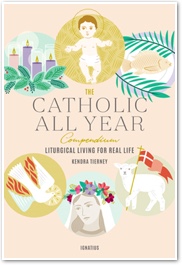Introduction: Catholic All Year
- KENDRA TIERNEY
I hoped to create for my family a home full of joy and faith and Catholic traditions.
Introduction
 I wrote this book because of International Talk Like a Pirate Day. Not that this book will help you talk like a pirate. Alas, ye scurvy landlubber, it won't. But the fact that there is a Talk Like a Pirate Day (September 19) and an Ice Cream for Breakfast Day (first Saturday of February) and a Clean Out Your Refrigerator Day (November 15) tells us something. When my social media feeds fill up with photos of donuts on the first Friday of June (National Donut Day), I can see that we as a society are hungry for community and shared experiences (and donuts, of course).
I wrote this book because of International Talk Like a Pirate Day. Not that this book will help you talk like a pirate. Alas, ye scurvy landlubber, it won't. But the fact that there is a Talk Like a Pirate Day (September 19) and an Ice Cream for Breakfast Day (first Saturday of February) and a Clean Out Your Refrigerator Day (November 15) tells us something. When my social media feeds fill up with photos of donuts on the first Friday of June (National Donut Day), I can see that we as a society are hungry for community and shared experiences (and donuts, of course).
And while I'm not here to tell you that you shouldn't observe Compliment Day on January 24 (I would never, and your hair looks great like that), I am here to tell you that, for Catholics, there is a whole world of days we could be celebrating together — days that have been marked by crazy community fun long before you could put a hashtag on it. We did it before. And there's no reason we can't do it again.
The Catholic Church recognizes more than ten thousand canonized saints, and each one has a feast day. A fraction of those show up on the free calendars they hand out at church, but for almost every day of the year, there are at least three saints from which to choose! Somewhere in the world, there are activities and foods and events traditionally used to celebrate each of those saints.
Saints' days plus days celebrating the founding of particular churches, the approved Marian apparitions, and the important events in the lives of Jesus, his mother Mary, and the first Christians make up the feasts of the year. Combined with days of fasting and seasons of preparation and celebration, you've got the liturgical year.
The calendar of the Catholic Church has, for centuries, set a rhythm for the year for the faithful. Planting particular crops and paying rent were associated with specific saints' days. Entire towns would fast together and feast together. Somewhere along the way, we have lost that cultural inheritance. Many of us have only the vaguest notion that the liturgical year even exists, let alone any idea of how to incorporate those days and that rhythm into our family life.
That's where I was as a young wife and a new mother. I was starting to rediscover the faith in which I grew up but into which I never really delved. I hoped to create for my family a home full of joy and faith and Catholic traditions, but I didn't know where to begin.
This book will not teach you how to talk like a pirate. But it will teach you what I have learned and discovered and compiled and invented over the last decade, during my slow and steady journey into liturgical living in the home.
Despite being the person writing this book, I do not claim to be an expert in theology, history, cooking, baking, crafting, party planning, or home decorating. I am, however, a very enthusiastic amateur practitioner of all the above. I am not a perfect mother or a perfect wife or a perfect Catholic. And while perfection is always the goal (see Mt 5:48), that's not what this book is about. This book isn't about Catholic perfection; it's about celebrating our common faith with family and friends.
Sometimes all you really need is a little enthusiasm and the willingness to give things a try.
Sometimes all you really need is a little enthusiasm and the willingness to give things a try. The easiest way is to start when your children are young enough to be dazzled by even your less successful endeavors. Case in point: I stood in my kitchen one Friday afternoon, looking at a slightly runny red gelatin heart, decorated with orange segments and pretzel sticks, sitting somewhat off-center on a cake plate. It was supposed to look like the Sacred Heart of Jesus, but it had looked better in my head — less oozy. My four-year-old daughter, however, took one look at it and gasped in wonder at its beauty. She called the other kids in to see it. They agreed that it was awesome but could use some whipped cream.
So that's what we did. We put some whipped cream on it. Over dinner, we talked about St. Margaret Mary Alacoque and her visions. We talked about the burning love that Jesus has for each one of us and the pain that he suffers because of the sin and the ingratitude of mankind. Then we ate the weepy heart. And now my kids can't imagine a feast of the Sacred Heart without one. That's what living the liturgical year looks like in our home.
In this book you will get that can't-miss dessert idea (obviously) plus dozens more ideas for activities, foods, crafts, and family adventures for the whole liturgical year, all of which require very little planning. I'll share the fun and heroic stories that the husband and I tell our kids to help them to love our favorite saints, and I'll explain how we talk to our kids about the less fun stuff, such as Judas' betrayal and the Passion of Our Lord.
You do not have to do everything in this book. You can be a good Catholic and do these things to celebrate the liturgical year. You can also be a good Catholic and do other things or no things at all to celebrate the liturgical year. Our family doesn't do everything in this book every year. And we certainly didn't do it all in the beginning. Start slowly. Add one observance at a time. If you love it, do it again next year. If you don't love it, wait a couple of years and try again. Or just chuck it entirely.
In addition to offering liturgical-living inspiration, this book peeks at the basics of Catholic life in a family, surrounded by schoolwork and commutes and cell phones and TV. Whether we are converts to Christianity or have come over to Catholicism from another denomination or are cradle Catholics who just never learned any of this stuff, there's a lot to learn. But together, maybe we can make it happen!
Sixteen years ago, when I first became a mother, I had no idea that it was possible for a regular family to live a full Catholic life in the midst of today's world with today's demands and expectations. But it is. It definitely is. You just need to know when to add whipped cream.
Something to keep in mind as you read: the Catholic Church is big and wide. It encompasses the whole world and many cultural traditions and liturgical rites. It is for all people in all circumstances. I've done my best to make this book useful and accessible to (and supportive of ) all Catholics, but my family and I are American, Ordinary Form, Latin Rite, Roman Catholics, and I'm a stay-at-home mom. This identity has shaped my personal knowledge and experience, and you'll see that reflected in the book. It's my hope that you'll be able to adapt for yourself and your circumstances what has worked for me and mine.
 This is Meaghen Gonzalez, Editor of CERC. I hope you appreciated this piece. We curate these articles especially for believers like you.
This is Meaghen Gonzalez, Editor of CERC. I hope you appreciated this piece. We curate these articles especially for believers like you.
Please show your appreciation by making a $3 donation. CERC is entirely reader supported.

Acknowledgement
 Kendra Tierney. "Introduction." from The Catholic All Year Compendium (San Francisco: Ignatius Press, 2018): 11-13.
Kendra Tierney. "Introduction." from The Catholic All Year Compendium (San Francisco: Ignatius Press, 2018): 11-13.
Reprinted with permission from Ignatius Press.
The Author

 Kendra Tierney is a wife and a mother of nine children from newborn to teenager. She's a homeschooler and a regular schooler, and an enthusiastic amateur experimenter in the domestic arts. She writes the award-winning Catholic mommy blog Catholic All Year, is a regular contributor to Blessed Is She Ministries, and is the voice of liturgical living at Endow Ministries. She is the author of The Catholic All Year Compendium: Liturgical Living for Real Life and A Little Book about Confession for Children.
Kendra Tierney is a wife and a mother of nine children from newborn to teenager. She's a homeschooler and a regular schooler, and an enthusiastic amateur experimenter in the domestic arts. She writes the award-winning Catholic mommy blog Catholic All Year, is a regular contributor to Blessed Is She Ministries, and is the voice of liturgical living at Endow Ministries. She is the author of The Catholic All Year Compendium: Liturgical Living for Real Life and A Little Book about Confession for Children.




